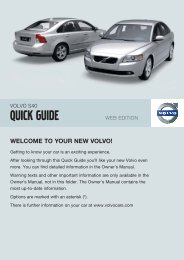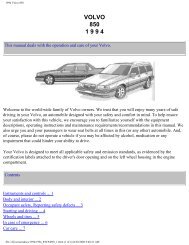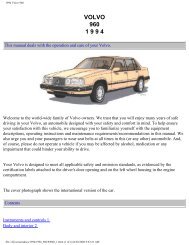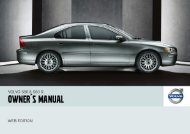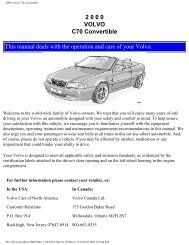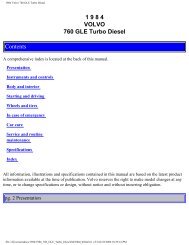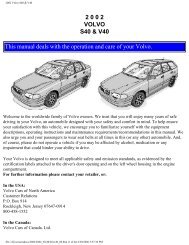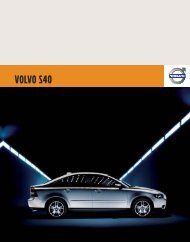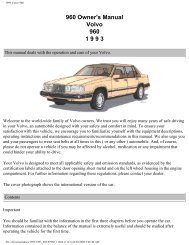V50 w646.book - ESD - Volvo
V50 w646.book - ESD - Volvo
V50 w646.book - ESD - Volvo
Create successful ePaper yourself
Turn your PDF publications into a flip-book with our unique Google optimized e-Paper software.
07 Wheels and tyres<br />
General<br />
Driving characteristics and tyres<br />
Speed ratings<br />
The car has "Whole Vehicle Type Approval",<br />
which means that dimensions and speed ratings<br />
must not differ from those specified on<br />
the vehicle’s registration document. The only<br />
exception to these conditions is winter tyres<br />
(both those with metal studs and those without).<br />
If such a tyre is chosen, the car must not<br />
be driven faster than the speed rating of the<br />
tyre (for example, class Q can be driven at a<br />
maximum of<br />
160 km/h).<br />
Remember that traffic regulations determine<br />
how fast a car can be driven, not the speed<br />
class of the tyres.<br />
Note! Maximum permitted speeds indicated.<br />
New tyres<br />
07<br />
The tyres greatly affect the car’s driving characteristics.<br />
The type of tyre, dimensions, tyre<br />
pressure and speed rating are important for<br />
how the car performs.<br />
When changing tyres, ensure that tyres of the<br />
same type and dimensions, and preferably<br />
also the same make, are fitted to all four<br />
wheels. Follow the recommended tyre pressures<br />
specified on the tyre pressure label,<br />
see page 158.<br />
Designation of dimensions<br />
The dimensions are stated on all car tyres.<br />
Example:<br />
205/55R16 91 W.<br />
205 Section width (mm)<br />
55 Ratio between section height and<br />
width (%)<br />
R Radial ply<br />
16 Rim diameter in inches (")<br />
91 Tyre load index (in this case 615 kg)<br />
W Speed rating (in this case 270 km/h).<br />
Q<br />
T<br />
H<br />
V<br />
W<br />
Y<br />
160 km/h (used only on winter tyres)<br />
190 km/h<br />
210 km/h<br />
240 km/h<br />
270 km/h<br />
300 km/h<br />
Tyres are perishable. After a<br />
few years they begin to<br />
harden at the same time as<br />
the friction capacity/characteristics<br />
gradually deteriorate.<br />
Therefore aim to get<br />
as fresh tyres as possible<br />
when you replace them. This is especially important<br />
with regard to winter tyres. The week<br />
and year of manufacture, the tyre’s DOT<br />
marking (Department of Transportation), are<br />
stated with four digits, for example 1502. The<br />
tyre in the illustration was manufactured in<br />
week 15 of 2002.<br />
Tyre age<br />
All tyres older than six years should be<br />
checked by an expert even if they seem undamaged.<br />
The reason for this is that tyres<br />
age and decompose, even if they are hardly<br />
ever or never used. The function can therefore<br />
be affected due to the tyre’s constituent<br />
materials being broken down. In such a case<br />
the tyre should then not be used. This also<br />
applies to spare tyres, winter tyres and tyres<br />
saved for future use. Examples of external<br />
signs which indicate that the tyre is unsuitable<br />
for use are cracks or discoloration. The<br />
age of the tyre can be determined by the<br />
DOT marking, see illustration above.<br />
154



